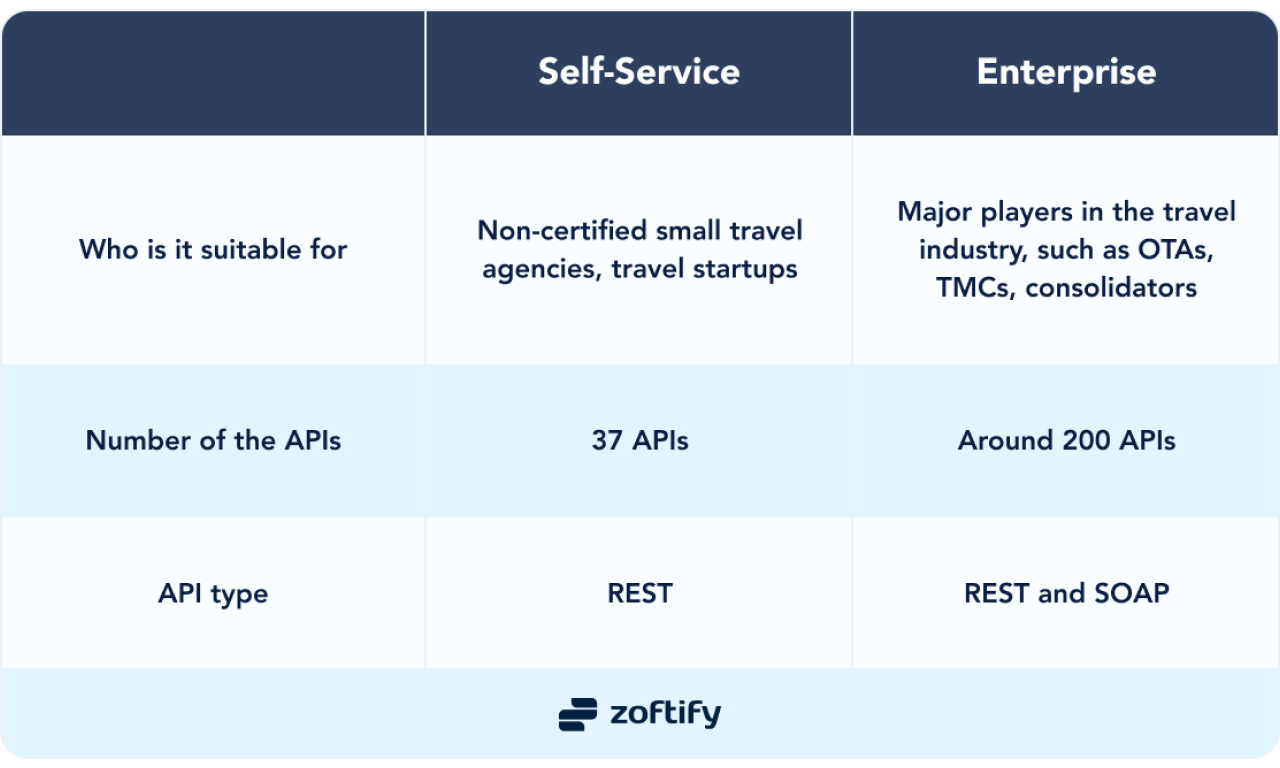Amadeus API integration: Get started with the global distribution system
Alex Ragin
Updated May 14, 2024 • 14 min read

Running a travel agency is not an easy job, but by using a global distribution system (GDS) you can simplify and optimize your processes. Global distribution systems are the backbones of the travel industry, connecting agencies to a wide array of travel providers and inventories around the world. Some of the leading GDS providers in the travel industry include Sabre, Travelport, and Amadeus, with Amadeus being one of the biggest GDS brands in Europe.
In this article, we’ll talk about how to integrate Amadeus APIs into your business operations, what essential aspects you need to be aware of, and the benefits it can bring to your travel agency.
What is a global distribution system (GDS)?
Put simply, global distribution systems (GDS) connect travel companies to multiple travel service providers. For example, instead of having to establish individual connections with every single airline, travel agencies can simply utilize the GDS to access data from all airlines and then offer a wide pool of options to customers. Travel agencies can use a GDS to get instant updates on flight schedules and their availability, and also for hotel room booking, car rentals, and other travel services.
One of the leading GDS providers is Amadeus. When a travel agent reserves a seat on a flight using Amadeus Flight API, the GDS sends these details to the airline's system and marks that seat as taken. The agent doesn't need to directly engage with the airline, and airline staff don't have to input any information. Think of a GDS as the middleman that does all the work.
What can Amadeus offer travel companies?
Amadeus offers a range of APIs that can be used for web and mobile applications. Their solutions can be grouped into two types: ‘Self-Service’ and ‘Enterprise’. Let's take a closer look at each category and the APIs your travel agency can benefit from.
Self-Service APIs
Amadeus Self-Service APIs are great for travel startups who want to benefit from GDS technologies without needing travel agency certifications. Self-Service APIs use modern REST architecture and JSON format for data exchange. They provide an easy and cost-effective way for businesses to access GDS functionalities and launch their travel ventures quickly.
The number of REST APIs is growing, with a total of 37 APIs in the Self-Service suite. There are lots of options to choose from, including Destination Experiences APIs and Itinerary Management APIs. But these two are great starter options for new travel businesses:
-
Flight Booking API
Amadeus Flight API integration gives you access to content from more than 400 airlines worldwide, so you can offer your customers a huge range of flights to choose from. The API also provides advanced features such as flight inspiration, multi-city search, cheapest available dates, and a calendar view, so you can give your customers the choice and freedom they want. Let them book the flights that suit them best, based on price, schedule, airline, and other factors.
-
Hotel Booking API
Amadeus Hotel Booking API integration connects you to more than 150,000 properties — and with real-time availability, you can reserve rooms instantly. Amadeus Hotel API integration provides detailed information for each hotel, so you can even match travelers to hotels that suit their needs and budget. Satisfied travelers means repeat bookings and more word-of-mouth promotion for your business.
Enterprise APIs
Amadeus is currently transitioning from SOAP to REST architecture, but the process is not yet complete. For larger travel businesses wanting access to the majority of features, SOAP is still required, and you’ll need an Enterprise subscription.
The modern Enterprise catalog offers approximately 200 APIs, including both SOAP and REST. Here are a few of the most essential ones that you can integrate into your travel business:
-
Flight Offers Search API
This API helps you find the most affordable flights based on specific needs, such as departure city or airport, travel dates, and passenger details. But it goes beyond this: it also offers essential information on things like baggage allowance, the cost of the first checked bag, and detailed fare conditions.
-
Car Rental API
Amadeus gives you access to more than 44 car providers in more than 42,000 locations worldwide. Your customers can book vehicles on the spot, while Amadeus GDS automatically manages the reservation, sending customers everything they need to pick up their vehicle. Integrating car rental services is a great way to provide additional value to your customers and open up new revenue streams for your business.
-
Train Booking API
You'll gain access to real-time schedules, fares, and availability for train travel in Europe and other territories. Tapping into Amadeus's rail inventory means you can sell tickets for high-speed trains like the TGV, AVE and ICE, as well as major operators such as Renfe, SNCF and Deutsche Bahn. This added offering allows you to earn commissions on those bookings, putting your company on the fast track to growth.
- Travel Insurance API
Offering travel insurance at the time of booking is a value-add for your customers and an upselling opportunity for your business. According to a recent survey by VisitorsCoverage, 79% of respondents said they planned to purchase trip protection when booking their travel. Amadeus Travel Insurance API provides real-time rates from major insurance suppliers so you can display quotes for policies that cover health, trip cancellations, baggage loss, and more. Customers can compare, select and purchase the coverage they want, all within your booking flow.

Key benefits of Amadeus for online travel agencies
Access to a vast global inventory
Online travel agencies (OTAs) like yours can gain access to 400+ airlines, more than 150,000 properties, numerous car rental companies, rail operators, and insurance providers. Giving customers maximum choice will go a long way to boosting customer satisfaction. You’ll also be able to curate appealing and unique travel packages that customers will love, increasing your value and setting your agency apart in today’s travel market.
Comprehensive travel itineraries
With Amadeus's renowned presence in Europe, Middle East, Latin America, and Asia Pacific, travel management companies (TMCs) get access to global data, meaning you can provide a more comprehensive and informed service. You’ll be able to put together meticulously detailed travel plans to ensure travelers have an easy, hassle-free journey.
Easy integration
Amadeus APIs offer a straightforward integration process for web and mobile apps, allowing you to access and query the inventories of multiple suppliers and facilitate bookings. Amadeus GDS is also incredibly user friendly, reducing entry barriers for newcomers and allowing it to slot into your business seamlessly.
Rich data and customization
Amadeus APIs provide ‘New Distribution Capability’ (NDC) — a modern communication standard developed by International Air Transportation Association (IATA) that allows airlines to deliver comprehensive personalized content and supplementary services straight to online travel agencies. By personalizing customers' experience, you can increase customer satisfaction and boost conversion rates.
Enhanced service level
Amadeus Flight Search API integration enables OTAs to perform low fare searches and offer special deals and flexible pricing. Customers will appreciate the effort in finding them the best deal — but the API has done all the work for you! Providing this enhanced level of service will boost customer satisfaction and loyalty.
Interested in Amadeus Airport API integration?
You’re flying in the right direction. Contact us to get started.
How to integrate Amadeus API: A step-by-step guide
The steps for setting up Amadeus’s Self-Service and Enterprise APIs are different.
Let’s start with Self-Service APIs. Here's how to get started with Amadeus Flight Booking API integration, as an example:
1. Set up your account
To get started, you'll need to create an account and verify yourself as an authorized developer by generating an access token. This will give you the credentials to start integrating the API.
2. Explore the resources
Amadeus offers a range of helpful tools to simplify the integration process. You can find code samples and software development kits (SDKs) on their official GitHub repository. These resources are available in popular programming languages like Ruby, Python, Java, Node.js, .NET, Kotlin (for Android development), and Swift (for iOS development).
3. Bring in a development team
At first glance, Self-Service APIs may not seem complicated, but there's more than meets the eye. Amadeus frequently updates their APIs but versions are not always well-documented — plus new versions may not be compatible with previous ones. That’s why it’s a good idea to work with a skilled development team. Here at Zoftify, we diligently track API changes and releases, ensuring our clients are on the safe side.
4. Test and fine-tune
Amadeus provides test environments where you can work with limited data and make use of a fixed number of free API calls each month. The free quota ranges from 200 to 10,000 requests, depending on the specific API, and your app can make one call every 100 milliseconds. This allows you to check everything is working correctly before moving on.
5. Make your first API call
Once you’re happy, you can make your first API call. After making the call, you'll get response data. It will be in JSON format, which is a standard for modern APIs and is relatively easy to work with. You need to interpret this response, extract the data you need, and implement it into your application. This generally involves storing the data and displaying it to your users in an understandable way.
6. Transition to production
Once your app is ready to go live, you can move it to the production environment. First, you'll need to request a production key. This requires providing personal and billing information, selecting a payment method, and signing the Terms of Service agreement. Next, the Amadeus team will validate your app and create a personal environment for you. This process usually takes up to 72 hours for the first app, but subsequent apps are approved much faster. Once everything is ready, you will be notified that you have access.
7. Get accreditations
If you plan to use Amadeus Flight Booking integration to issue tickets, you must comply with local regulations, ensure the API is available in your region, and most importantly, sign an agreement with an airline consolidator. Accreditation from the Airline Reporting Corporation (ARC) in the US or the International Air Transport Association (IATA) for the rest of the world is also necessary. If you don't have these accreditations, you can partner with an IATA/ARC-accredited entity that can handle the ticketing process for you.
Amadeus Flight Booking system API integration with the Enterprise subscription is a little more complicated. We’ve summarized the process in a few clear steps:
1. Contact Amadeus for access
Enterprise level integrations require a bit more effort. You'll need to meet certain standards, like being IATA/ARC certified, and speak to Amadeus — this can take a few weeks.
2. Sign a contract and start building
Once you've signed on the dotted line, you're all set to start building and testing your integration using test data in the Enterprise API sandbox.
3. Consider hiring a development team
Working with SOAP APIs can be a bit of a headache. To make things easier, you might want to hire a development team like Zoftify, with plenty of experience with Amadeus Enterprise integrations.
4. Certify your app
Before your app goes live, it needs to be certified by Amadeus to make sure everything's working as it should. This can take a few weeks rather than days as with the Self-Service subscription. As part of the certification, you'll need to make a sequence of requests to model a few standard situations — for example, for Flight API, this could be booking a round trip ticket for one person. Then, you’ll need to sign each call with your unique ID, send the log with requests and responses to Amadeus, wait for feedback, make corrections, send another log, and then wait some more. The waiting game is usually the longest part of the process.
5. Switch to production
Finally, Amadeus will switch your integrations to the production environment. This means you'll be working with real data. Depending on your target region, your account will be configured to return the most recent prices and actual information on availability.
How much does Amadeus cost?
Amadeus offers different pricing systems for Self-Service and Enterprise. With the Self-Service subscription, you can develop for free with a quota of free calls. After launch, you'll still get the same number of free calls as in the test environment, but if you exceed the limit, the system will automatically charge a fee for each transaction. The fee amount ranges from €0.0008 to €0.025 or $0.00078 to $0.024, depending on the API.
There’s a different payment structure for Enterprise users. For Enterprise, you’ll pay a monthly fee that covers support services and the free request quota. This fee is determined when the contract is signed.
In addition to this, Amadeus charges Enterprise users a fee based on the look-to-book ratio, which is a comparison of how often an inventory is checked to the number of bookings made. When there are a lot of bookings, Enterprise users often end up paying less than Self-Service users, making it a cost-effective choice for businesses with substantial booking volumes.
Can I do the Amadeus API integration myself?
It is possible to do an Amadeus travel API integration by yourself, but it requires significant technical knowledge and experience and can be costly. If you have development skills and are comfortable working with APIs, you might be able to handle the integration yourself. But it is recommended that most travel agencies work with an integration specialist.
While Amadeus has lots of helpful information to get you started, it can take a while to get comfortable with all the API capabilities. Doing an integration requires setting up web services, handling authentication, parsing XML/JSON response data, among other technical tasks. You also need to stay up-to-date with any changes Amadeus makes to their API.
That’s why it’s often best to work with professionals who know and track those things. An integration partner like Zoftify already knows the ins and outs of the Amadeus GDS and can offer guidance on the best practices to create a successful solution for your business.

Amadeus partners also have a direct line of communication with the Amadeus support team, making it quicker to resolve any problems. While Amadeus does offer support for their APIs, the level of support for those who integrate by themselves can be limited. Partners like Zoftify also have experience with Amadeus's testing environments, which helps troubleshoot problems before pushing changes to production. And where API documentation may seem complex to an untrained eye, for seasoned developers it's like reading their favorite book.
Conclusion
To sum it up, Amadeus GDS can give your travel agency comprehensive data that you can leverage to expand your offering and ultimately reach new audiences. Even though it can be a bit tricky to set up Amadeus APIs, the benefits, like access to global travel options and the ability to curate detailed travel plans, make it worth the effort.
It's often sensible to work with Amadeus experts who know how to handle API setups and specialize in Amadeus API integration services. This way, your travel agency can concentrate on what they do best — providing top-notch travel experiences.
Experience the ease of integration with Zoftify.
We know everything about Amadeus APIs. Make the call today.
Alex loves travel and tech and founded Zoftify to help travel companies use technology more effectively. Before this, he worked in tech consulting, where he led international mobile development teams.
4.93 (27)